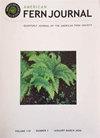表生蕨类植物二叉Platycerium biculum和二叉Asplenium nidus以及陆生蕨类植物毛状Aspleniu的脂肪酸组成
IF 0.9
4区 生物学
Q4 PLANT SCIENCES
引用次数: 6
摘要
摘要蕨类植物是地球上第二大种类的高等植物。然而,这些植物的代谢过程,以及它们对各种环境因素影响的反应,都受益于新的研究。在种子植物中,脂质脂肪酸(FA)成分在植物对各种环境条件的反应中的重要作用已被反复证明。本文采用气相色谱-质谱联用技术对附生蕨类植物二叉Platycerium biculum和二叉Asplenium nidus以及陆生蕨类植物毛状Aspleniu中的FAs组成进行了分析。所获得的数据清楚地表明,附生蕨类植物在其FA的组成中具有几个独特的特征。它们的特征在于高水平的饱和FA(约50%)和多种非常长链FA(VLCFA)。这与陆地蕨类植物中不饱和脂肪酸占主导地位的脂肪酸组成形成了强烈对比。高水平的饱和脂肪酸,特别是棕榈酸(16:0),加上高VLCFA含量,可能是与微生物复杂相互作用的必要成分。因此,P.biculum和A.nidus的特定FA组成既可以作为抵抗细菌和病原真菌渗透的保护机制,也可以作为附生植物与腐生真菌相互作用的机制。附生蕨类植物中FA的组成可能由其栖息地决定,并在植物与环境的相互作用中发挥着积极作用。本文章由计算机程序翻译,如有差异,请以英文原文为准。
Fatty Acids Composition of the Epiphytic Ferns, Platycerium bifurcatum and Asplenium nidus, and the Terrestrial Fern, Asplenium trichomanes
Abstract. Ferns are the second most diverse group of higher plants on the planet. However, the metabolic processes of these plants, as well as their reaction to the influence of various environmental factors, benefit from new investigation. In seed plants, an important role of the lipid fatty acid (FA) composition in plant response to a variety of environmental conditions has been repeatedly demonstrated. In this paper, the composition of FAs in the epiphytic ferns, Platycerium bifurcatum and Asplenium nidus, and the terrestrial fern, Asplenium trichomanes was analyzed by gas-liquid chromatography with mass spectrometry. The data obtained clearly indicate that epiphytic ferns have several distinctive features in the composition of their FAs. They are characterized by a high level of saturated FAs (about 50%) and a great variety of very-long-chain FAs (VLCFA). This strongly contrasts with the FAs composition in the terrestrial fern in which unsaturated FAs prevail. High levels of saturated fatty acids, in particular palmitic acid (16:0), together with a high VLCFA content, can be a necessary component in complex interactions with microorganisms. Thus, the specific FA composition of P. bifurcatum and A. nidus may act both as a protective mechanism against the penetration of bacteria and pathogenic fungi, and as a mechanism for the interaction of the epiphytes with saprophytic fungi. It is likely that the composition of FAs in the epiphytic ferns is determined by their habitat and plays an active role in the interaction of plants with their environment.
求助全文
通过发布文献求助,成功后即可免费获取论文全文。
去求助
来源期刊

American Fern Journal
生物-植物科学
CiteScore
1.20
自引率
0.00%
发文量
28
审稿时长
6 months
期刊介绍:
The American Fern Journal is a peer-reviewed journal focused on the biology of ferns and lycophytes.
 求助内容:
求助内容: 应助结果提醒方式:
应助结果提醒方式:


